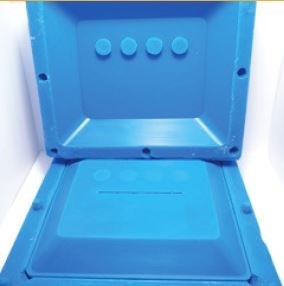3D Printing Helps Prove Sensor Marketability in Low Volume
Before going into full-scale production for a water sensor system, Sensocare used 3D-printed master molds and parts to produce an initial run.
Fish farming requires farmers to closely monitor water conditions to control rearing operations and yield an ideal harvesting rate. Sensors are increasingly being used to help farmers automatically detect factors such as water acidity level and plankton blooms, and manage their operations accordingly. Sensocare, the manufacturer of the Aquafarm Water Sensor System, recently used 3D printing for time and cost savings in bringing this solution to market.
Based in Singapore, Sensocore is a subsidiary under CamTech Diagnostics, a company that regularly uses 3D printing to produce master molds for silicone molding. The company originally used a consumer-grade 3D printer for this application, but this printer had limitations in accuracy and surface finish that made it necessary to spend hours sanding and touching up the prints, often at risk of damage to the parts during postprocessing. Additionally, certain features such as thin walls could not be replicated accurately.
To create thin-walled masters with smooth surface finish resembling end-use parts, CamTech purchased a Stratasys Eden 260VS industry-grade 3D printer from Creatz3D. This printer uses PolyJet technology, which works similar to an inkjet printer by depositing droplets of photocurable liquid material onto a build tray in layers as fine as 16 microns. The material is simultaneously cured as it is deposited via UV light.
Being able to 3D print master tooling for silicone molding saved the company time in manufacturing parts, reducing lead time from 2 to 3 weeks down to 36 hours. Costs were also reduced by more than 90 percent.
Following initial sales of the water sensor system and feedback from customers, Sensocore realized that the function button panel might malfunction from being exposed to the elements. The company designed a sleeve protector that would wrap around the system, ensuring a snug fit and keeping out the water. The sleeve itself was 3D-printed from urethane rubber and silicone materials selected for their rigid, flexible, durable, and high-temperature resistant properties. It took just 4 days to produce the 3D-printed sleeve, a time savings of 86 percent and cost savings of 95 percent over traditional manufacturing. Any future variations in the part can be easily customized with CAD with little to no cost.
Sensocore says that 3D printing enabled it to prove the marketability of the product in low volume, with a plan to pursue mass production using traditional manufacturing methods when orders increase.
Related Content
-
VulcanForms Is Forging a New Model for Large-Scale Production (and It's More Than 3D Printing)
The MIT spinout leverages proprietary high-power laser powder bed fusion alongside machining in the context of digitized, cost-effective and “maniacally focused” production.
-
At General Atomics, Do Unmanned Aerial Systems Reveal the Future of Aircraft Manufacturing?
The maker of the Predator and SkyGuardian remote aircraft can implement additive manufacturing more rapidly and widely than the makers of other types of planes. The role of 3D printing in current and future UAS components hints at how far AM can go to save cost and time in aircraft production and design.
-
Video: 5" Diameter Navy Artillery Rounds Made Through Robot Directed Energy Deposition (DED) Instead of Forging
Big Metal Additive conceives additive manufacturing production factory making hundreds of Navy projectile housings per day.
















